Glauconite
| Glauconite | |
|---|---|
 Glauconite pellets and small fossils among quartz grains in greensand from the Dutch Pliocene | |
| General | |
| Category | Phyllosilicate |
| Formula (repeating unit) | (K,Na)(Fe,Al,Mg)2(Si,Al)4O10(OH)2 |
| IMA symbol | Glt[1] |
| Crystal system | Monoclinic |
| Crystal class | Prismatic (2/m) (sameH-M symbol) |
| Space group | C2/m |
| Unit cell | a = 5.234 Å, b = 9.066 Å, c = 10.16 Å; β = 100.5°; Z = 2 |
| Identification | |
| Color | Blue green, green, yellow green |
| Crystal habit | Elastic platy/micaceous, or as rounded pellets/aggregates |
| Cleavage | Perfect [001] |
| Mohs scalehardness | 2 |
| Luster | Dull, earthy |
| Streak | Light green |
| Diaphaneity | Translucent to nearly opaque |
| Specific gravity | 2.4–2.95 |
| Optical properties | Biaxial (-); moderaterelief |
| Refractive index | nα= 1.590 – 1.612 nβ= 1.609 – 1.643 nγ= 1.610 – 1.644 |
| Birefringence | δ = 0.020 – 0.032 |
| Pleochroism | X = yellow-green, green; Y = Z = deeper yellow, bluish green |
| Other characteristics | loosely bound aggregates, crumbles radioactivity: barely detectable |
| References | [2][3][4] |
Glauconiteis anironpotassiumphyllosilicate(micagroup)mineralof characteristic green color which is veryfriable[5]and has very low weathering resistance.
Itcrystallizeswith amonoclinicgeometry. Its name is derived from theGreekglaucos(γλαυκός) meaning 'bluish green', referring to the common blue-green color of the mineral; its sheen (micaglimmer) and blue-green color. Its color ranges from olive green, black green to bluish green, and yellowish on exposed surfaces due to oxidation. In theMohs scaleit has a hardness of 2, roughly the same asgypsum.[6]The relativespecific gravityrange is 2.4–2.95. It is normally found as dark green rounded concretions with the dimensions of asandgrain. It can be confused withchlorite(also of green color) or with aclay mineral.Glauconite has the chemical formula(K,Na)(Fe,Al,Mg)2(Si,Al)4O10(OH)2.
Glauconite particles are one of the main components ofgreensand,glauconiticsiltstoneandglauconitic sandstone.Glauconite has been called amarlin an old and broadsenseof that word. Thus references to "greensand marl" sometimes refer specifically to glauconite. TheGlauconitic Marlformation is named after it, and there is a glauconitic sandstone formation in theMannville GroupofWestern Canada.
Occurrence
[edit]At the broadest level, glauconite is anauthigenicmineral and forms exclusively in marine settings.[7]It is commonly associated with low-oxygen conditions.[8]
Normally, glauconite is considered a diagnostic mineral indicative ofcontinental shelfmarinedepositional environmentswith slow rates of accumulation and gradational boundaries. For instance, it appears inJurassic/lowerCretaceousdeposits ofgreensand,so-called after the coloration caused by glauconite, its presence gradually lessening further landward. It can also be found in sand or clay formations, or in impurelimestonesand inchalk.It develops as a consequence ofdiageneticalteration of sedimentary deposits at the surface, bio-chemical reduction and subsequent mineralogical changes affecting iron-bearing micas such asbiotite,and is also influenced by the decaying process of organic matter degraded by bacteria in marine animal shells. In these cases, the organic matter creates the reducing environment needed to form glauconite within otherwise oxygenated sediment. Glauconite deposits are commonly found in nearshore sands, open oceans and shallow seas, such as theMediterranean Sea.Glauconite remains absent in fresh-water lakes, but is noted in shelf sediments of the westernBlack Sea.[9]The wide distribution of these sandy deposits was first made known by naturalists on board the fifthHMSChallenger,in the expedition of 1872–1876.
Uses
[edit]Glauconite has long been used in Europe as a greenpigmentfor artistic oil paint under the namegreen earth.[10][11]One example is its use in Russian "iconpaintings ", another widespread use was for underpainting of human flesh in medieval painting.[12]It is also found as mineral pigment in wall paintings from the ancientRoman Gaul.[13]
Fertilizers
[edit]Glauconite, a major component ofgreensand,is a common source ofpotassium(K+) in plantfertilizersand is also used to adjustsoil pH.It is used forsoil conditioningin bothorganicand non-organic farming, whether as anunprocessed material(mixed in adequate proportions) or as afeedstockin thesynthesisof commercial fertilizer powders. InBrazil,greensand refers to a fertilizer produced from a glauconiticsiltstoneunit belonging to theSerra da SaudadeFormation,BambuíGroup, ofNeoproterozoic/Ediacaranage. The outcrops occur[14]in theSerra da Saudaderidge, in theAlto Paranaíbaregion,Minas Geraisstate. It is a silty-clayed sedimentary rock, laminated, bluish-green, composed of glauconite (40-80%), potassiumfeldspar(10-15%),quartz(10-60%),muscovite(5%) and minor quantities ofbiotite(2%),goethite(<1%),titaniumandmanganeseoxides (<1%), barium phosphate andrare-earth elementphosphates (<1%).
Enriched levels of potash haveK2Ogrades between 8 and 12%, thickness up to 50 metres (160 ft) and are associated to the glauconitic levels, dark-green in color. Glauconite isauthigenicand highlymature.The high concentration of this mineral is related to a depositional environment with a low sedimentation rate. The glauconitic siltstone has resulted from a high-level flooding event in the Bambuí Basin. The sedimentaryprovenanceis fromsupracrustalfelsicelements in acontinental marginenvironment with acidmagmatic arc(foreland basin).
References
[edit]- ^Warr, L.N. (2021)."IMA–CNMNC approved mineral symbols".Mineralogical Magazine.85(3): 291–320.Bibcode:2021MinM...85..291W.doi:10.1180/mgm.2021.43.S2CID235729616.
- ^Handbook of Mineralogy
- ^Webmineral
- ^Mindat
- ^Odin, G.S. (ed., 1988). Green marine clays. Development in sedimentology, 45. Elsevier, Amsterdam.
- ^"Mohs Hardness Scale: Testing the Resistance to Being Scratched".geology.Retrieved2024-04-10.
- ^Smith, S. A., and Hiscott, R. N. (1987). Latest Precambrian to Early Cambrian basin evolution, Fortune Bay, Newfoundland fault–bounded basin to platform. Canadian Journal of Earth Sciences 21:1379–1392.
- ^Hiscott, R. N. (1982). Tidal deposits of the Lower Cambrian Random Formation, eastern Newfoundland; facies and paleoenvironments. Canadian Journal of Earth Sciences 19:2028–2042.
- ^Suttill H. (2009). Sedimentological evolution of the Emine & Kamchia basins, eastern Bulgaria. Thesis submitted for the degree of Master of Philosophy. Available from:the University of Edinburgh
- ^Grissom, C.A. Green Earth, in Artists’ Pigments. A Handbook of Their History and Characteristics, Vol. 1, L. Feller, (Ed), Cambridge University Press, London 1986, pp. 141 – 167
- ^Green earthColourlex
- ^Grissom, C.A. Green Earth, in Artists’ Pigments. A Handbook of Their History and Characteristics, Vol. 1, L. Feller, (Ed), Cambridge University Press, London 1986, p. 143
- ^Eastaugh, N "Pigment Compendium: A Dictionary of Historical Pigments", page 169. Elsevier, 2004
- ^Silvano Moreira, Débora (2016)."Estratigrafia, petrografia e mineralização de potássio em siltitos verdes do Grupo Bambuí na Região de São Gotardo, Minas Gerais"(PDF).Revista Geociências.35:157–171 – via UNESP.
